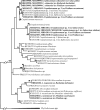Diversity and phylogenetic relationships of European species of Crepidostomum Braun, 1900 (Trematoda: Allocreadiidae) based on rDNA, with special reference to Crepidostomum oschmarini Zhokhov & Pugacheva, 1998
- PMID: 30266086
- PMCID: PMC6162956
- DOI: 10.1186/s13071-018-3095-y
Diversity and phylogenetic relationships of European species of Crepidostomum Braun, 1900 (Trematoda: Allocreadiidae) based on rDNA, with special reference to Crepidostomum oschmarini Zhokhov & Pugacheva, 1998
Abstract
Background: Within the genus Crepidostomum Braun, 1900, identification of species and taxonomic decisions made only on the basis of adult morphology have resulted in great problems associated with evaluating actual diversity and validity of species. Life-cycle data, while equal in importance to adult characters, are scarce, controversial or incomplete for most Crepidostomum spp. In this study, rDNA sequences generated from adult and larval Crepidostomum spp. and some other allocreadiid species were analysed to reveal the diversity and phylogenetic relationships of the species and their host range. Detailed morphological description based on light microscopy, SEM tegumental surface topography and genetic data are provided for the poorly known trematode C. oschmarini Zhokhov & Pugacheva, 1998 found in the intestine of two teleost fish species, Barbatula barbatula (L.) and Cottus gobio L.
Results: We characterized 27 isolates of adult and larval parasites. Based on newly obtained 28S and ITS1-5.8S-ITS2 rDNA sequences, new intermediate and final hosts were ascertained, and life-cycles clarified for some allocreadiids. New knowledge on the diversity and phylogenetic relationships of European Crepidostomum spp. was gained. The validity of C. oschmarini was verified based on comparative sequence analysis. Ophthalmoxiphidiocercariae of C. oschmarini were recorded in sphaeriid bivalves Pisidium (Euglesa) casertanum (Poli). Additionally, morphological differences between gravid specimens of C. oschmarini and other related species were observed.
Conclusions: Species of the Allocreadiidae parasitizing fishes in Europe are distributed among two monophyletic genera, Allocreadium and Bunodera, and two paraphyletic Crepidostomum clades. A complex of Crepidostomum metoecus (syn. C. nemachilus), C. oschmarini and Crepidostomum sp. 2 clustered in one clade, and a complex of C. farionis, Crepidostomum sp. 1 and, probably, C. wikgreni in the other. Molecular data indicated that C. oschmarini and Crepidostomum sp. 2 presumably have a wide geographical distribution in Europe. The new data provided evidence that Crepidostomum is a more diverse genus than can be judged from morphological data and host switching in this genus may occur independently of fish-host phylogeny.
Keywords: 28S; Crepidostomum oschmarini; European bullhead Cottus gobio; ITS2 rDNA; Life-cycles; Molecular phylogeny; Morphology; Stone loach Barbatula barbatula; Tegumental topography.
Conflict of interest statement
Ethics approval and consent to participate
Not applicable.
Consent for publication
Not applicable.
Competing interests
The authors declare that they have no competing interests.
Publisher’s Note
Springer Nature remains neutral with regard to jurisdictional claims in published maps and institutional affiliations.
Figures





References
-
- Caira JN. A revision of the North American papillose Allocreadiidae (Digenea) with independent cladistics analyses of larval and adult forms. Bull Univ Nebr State Mus. 1989;11:1–58.
-
- Caira JN, Bogea T. Family Allocreadiidae Looss, 1902. In: Jones A, Gibson DI, Bray RA, editors. Keys to the Trematoda, Volume 2. Wallingford: CABI Publishing and the Natural History Museum. 2005. pp. 417–436.
-
- Gibson DI. Trematoda. In: Margolis L, Kabata Z, editors. Guide to the Parasites of Fishes of Canada, part IV. Canadian Special Publication of Fisheries and Aquatic Sciences, Vol. 124. Ottawa: NRC Research Press; 1996.
-
- Bykhovskaya-Pavlovskaya IE, Kulakova AP. Trematoda. In: Bauer ON, editor. Key to Parasites of Freshwater Fishes of USSR, Volume 3. Leningrad: Nauka; 1987. p. 77–198 (In Russian).
MeSH terms
Substances
Grants and funding
LinkOut - more resources
Full Text Sources
Other Literature Sources
Molecular Biology Databases
Miscellaneous

